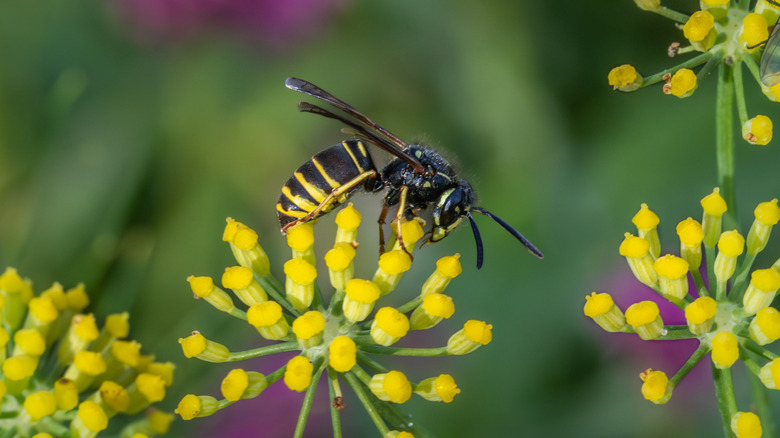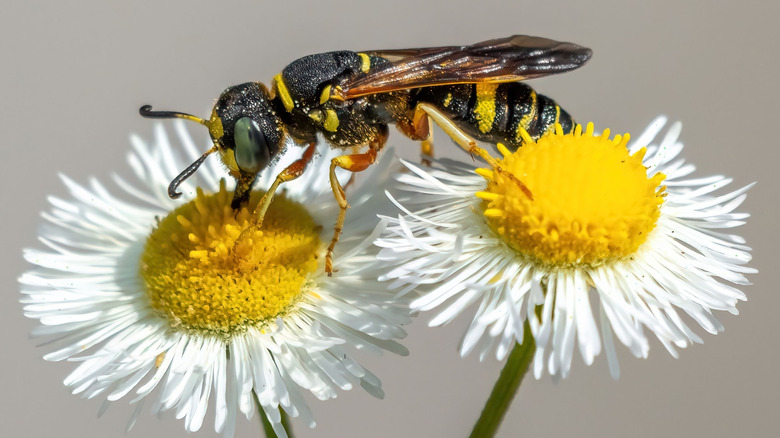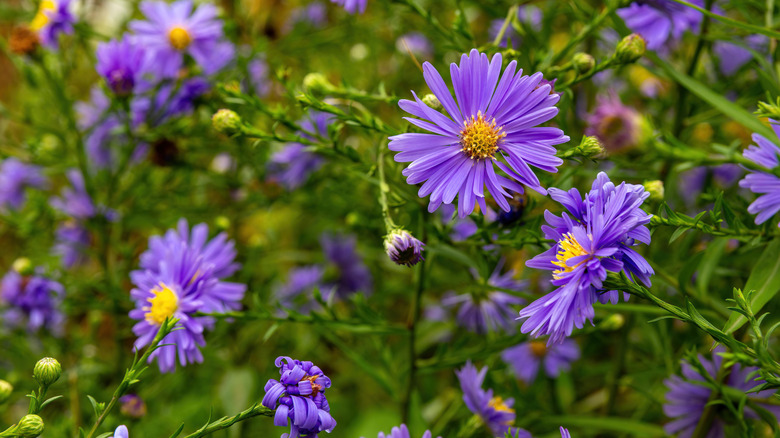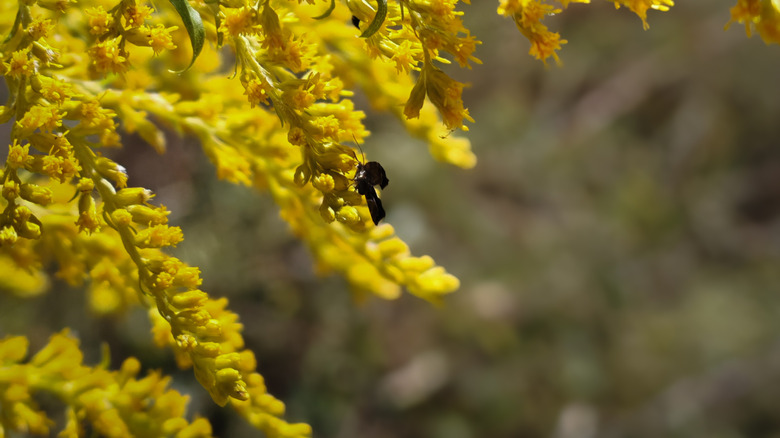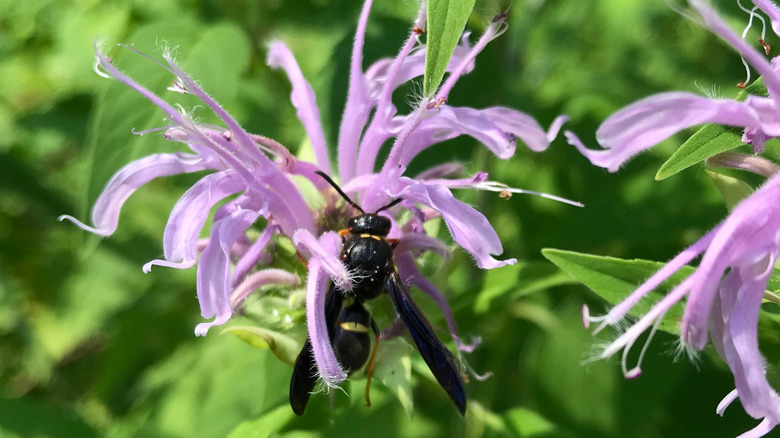12 Plants That Are Attracting Unwanted Wasps To Your Yard Or Garden
Wasps often get a bad rap — probably because when we think of them, we think of yellowjackets dive-bombing the lemonade we're trying to drink on our patio. But it might be more than lemonade bringing them into the garden. Did you know there could be plants attracting wasps to your yard? These sometimes scary insects' favorite flowers include Queen Anne's lace, fennel, asters, and goldenrod.
While we might not like wasps, it's important to note that most are actually beneficial pollinators in the yard. In fact, they might be as important as bees or butterflies. Wasps prey on aphids and other pests that do a lot of damage in the garden. They're voracious eaters, too, with some colonies of wasps wind up eating more than 2 pounds worth of insects in their territory. And sometimes wasps target serious bugs, like the emerald ash borer, which can take down entire ash trees if left alone.
But if you have a wasp allergy, or you simply want to cut back on the number you see in your yard, then you'll look at this list as what to avoid planting in your garden. If you want more wasp pollinators, then feel free to plant more of their favorites. Wasps love flowers that either offer up nectar for them to drink, or attract the bugs they like to prey on, or in some cases, both. Keep reading for 12 of the top plants that might be attracting wasps into the garden.
Wasps prefer Queen Anne's lace
Wasps adore Queen Anne's lace (Daucus carota) and many other members of the Apiaceae family because they offer up many shallow flowers with nectar that they can easily access. From afar, Queen Anne's lace might look like one big white flower, but there are actually many small ones clumped together, all with nectar-rich centers. Unlike hummingbirds or butterflies, wasps tend to have very short tongues ... or technically what's called a proboscis. That's a kind of tongue that works more like a straw. That means wasps prefer shallow flowers, like Queen Anne's lace.
Fleabane doesn't repel fleas, but it does attract wasps
Fleabane (Erigeron philadelphicus) has less to do with repelling fleas and more to do with attracting wasps and other pollinators — its use as any sort of insect repellent is nothing more than an unsubstantiated myth. The flying insects love the nectar from this short-lived perennial, and they also won't mind feeding on the other bugs that might be attracted to this cheerful flower, too. It's part of the Asteraceae family, which also includes daisies, dahlias, and many more common garden flowers.
Black-eyed Susans bring in wasps
Wasps love the color yellow, so it's no wonder that the bright yellow black-eyed Susan tops their list. The golden-hued petals draw them in, and the nectar keeps them there. To us, each black center surrounded by bright petals looks like one flower — but to bugs, that eye of the flower holds up to 200 tiny individual flowers. That's why you might notice if a bee or butterfly lands on this bloom. Maybe it'll work its way around the circle, drinking from many little reservoirs. Think of it like an all-you-can-eat buffet for pollinators.
New England asters draw wasps to your garden
While the purple New England aster might seem like the wrong color hue for a wasp, they'll still make a beeline (pun intended) for the nectar-rich yellow centers. These avid blooming perennials grow up to 7 feet tall, and become attractive to all kinds of bugs and animals. Caterpillars munch on leaves and songbirds eat the seeds in the center. If you decide you don't mind a few extra wasps in the yard, then you can plant this underrated flower in August and it will look stunning in the fall.
Wasps choose boneset flowers
Clumping flowers like boneset (Eupatorium perfoliatum) also attract wasps and other pollinators, since their clusters of shallow, white flowers make for easy-access nectar. Some believe that boneset has medicinal purposes. Centuries ago, people may have even tried to use it to heal broken bones — hence its name. Wasps and bees love this plant so much that you might see many of them at a time helping themselves to a free lunch. If you see a blue-winged wasp, you might want to leave it be, since this solitary wasp preys on Japanese beetles.
Fewflower milkweed gives wasps sweet nectar
Wasps and bees flock to fewflower milkweed (Asclepias lanceolata) for its delicious, sugary nectar. The distinctive orange blooms come in bunches offering lots of nectar to hungry pollinators. Many kinds of butterflies, including monarchs, love this flower. An interesting fact about this perennial: Its milky sap is toxic to many animals, including humans — but monarch caterpillars are immune to the poison. They can happily munch leaves or stems all day with no adverse side effects. Wasps will likely stick to the flowers.
Wasps fly to the beargrass
When it comes to a wasp's preferred plant, count the white globe flowers of beargrass (Eryngium yuccifolium) at the top of the list. Also known as rattlesnake master, this herbaceous perennial was once used by Native Americans for medicinal purposes, but it's unclear whether it was actually used for snake bites. Beargrass attracts all kinds of pollinators, including wasps, bees, and butterflies. One particular moth, the stemborer moth, chooses this plant as a home for its eggs and larva.
Golden Alexander attracts wasps
Wasps love yellow in part because it's one of the colors they can see clearly. They have a different color spectrum than ours, and they focus more on ultraviolet colors than we do. Golden Alexander (Zizia aurea) offers their favorite hue of yellow. Plus, these flowers provide a whole lot of nectar, since its flower clusters often stretch around 3 inches wide. Wasps aren't the only ones noticing this flower, either. The North Carolina Botanical Garden named it the 2012 flower of the year.
Wasps can't resist goldenrod
Since we're talking about golden flowers, another yellow flower at the top of any wasp's list is goldenrod (Solidago spp.). If you want to know why wasps love this yellow, nectar-rich perennial and cousin of the daisy, it's partially about its color, yes ... but it also has something to do with when goldenrod blooms. This late-blooming flower gives nectar in the late summer or fall when some of a wasp's other favorite blooms have wilted. No doubt that this late-season snack also makes it a favorite among many types of bees as well.
Cilantro isn't just a garnish, wasps love it too
Cilantro (Coriandrum sativum), also known as Chinese parsley, might be better known for its tasty leaves that find their way into all kinds of yummy recipes. But if left to bolt, the cilantro plant also produces pretty small clusters of white flowers that are the perfect size for pollinators like wasps. If you want to try to keep wasps away from your cilantro or your garden, try planting companion flowers nearby they don't like, such as marigolds or mint.
Wasps and bees love bee balm
Turns out, bees aren't the only ones attracted to the bee balm flower (Monarda spp.). Wasps also take advantage of this high-calorie bloom whenever they can. It's not just the nectar, either, that draws them in — but also prey such as aphids and beetles. Who can blame them for wanting to drink nectar and get a protein snack at the same time? Plus, bee balm also attracts bumblebees and carpenter bees, as well as some kinds of solitary wasps like the great black wasp. Remember, solitary wasps aren't territorial, unlike their yellowjacket cousins.
Fennel will keep wasps coming back
Fennel (Foeniculum vulgare) checks everything on a wasp's most-wanted list: Sweet nectar, shallow petals, yellow flowers – and, it attracts all kinds of potential prey. People love fennel, too, since we use its seeds to season everything from soups to salads. However, a desire to avoid wasps isn't the only reason to keep fennel out of the garden. This herbaceous perennial often behaves as an aggressive self-seeder, and it can take over the garden bed if you let it.
